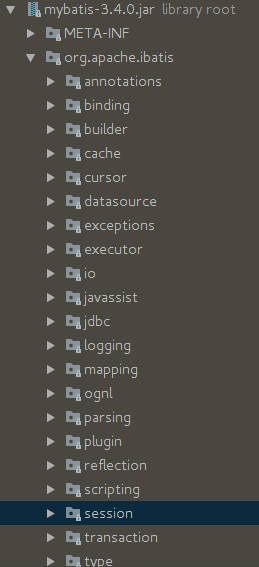mybatis源码笔记
mybatis设计总览

目录结构:

通过配置文件,获取SqlSessionFactory
XMLConfigBuilder 解析配置文件,获取SqlSessionFactory
private static SqlSessionFactory getSqlSessionFactory() {
String resource = "mybatis/mybatis-config.xml";
InputStream inputStream = null;
try {
inputStream = Resources.getResourceAsStream(resource);
} catch (IOException e) {
e.printStackTrace();
}
SqlSessionFactory sqlSessionFactory = new SqlSessionFactoryBuilder().build(inputStream);
return sqlSessionFactory;
}
mybatis-config.xml,数据源和mapper配置文件
<?xml version="1.0" encoding="UTF-8" ?>
<!DOCTYPE configuration
PUBLIC "-//mybatis.org//DTD Config 3.0//EN"
"http://mybatis.org/dtd/mybatis-3-config.dtd">
<configuration>
<typeAliases>
<typeAlias type="entity.User" alias="User"/>
</typeAliases>
<environments default="development">
<environment id="development">
<transactionManager type="JDBC"/>
<dataSource type="POOLED">
<property name="driver" value="com.mysql.jdbc.Driver"/>
<property name="url" value="jdbc:mysql://localhost/mybatisLearn"/>
<property name="username" value="mysql"/>
<property name="password" value="mysql"/>
</dataSource>
</environment>
</environments>
<mappers>
<mapper resource="mapper/UserMapper.xml"/>
</mappers>
</configuration>
SqlSessionFactory的属性和方法
private final Configuration configuration;
public SqlSession openSession() {
return this.openSessionFromDataSource(this.configuration.getDefaultExecutorType(), (TransactionIsolationLevel)null, false);
}
private SqlSession openSessionFromDataSource(ExecutorType execType, TransactionIsolationLevel level, boolean autoCommit) {
Transaction tx = null;
DefaultSqlSession var8;
try {
Environment environment = this.configuration.getEnvironment();
TransactionFactory transactionFactory = this.getTransactionFactoryFromEnvironment(environment);
tx = transactionFactory.newTransaction(environment.getDataSource(), level, autoCommit);
Executor executor = this.configuration.newExecutor(tx, execType);
var8 = new DefaultSqlSession(this.configuration, executor, autoCommit);
} catch (Exception var12) {
this.closeTransaction(tx);
throw ExceptionFactory.wrapException("Error opening session. Cause: " + var12, var12);
} finally {
ErrorContext.instance().reset();
}
return var8;
}
SqlSessionFactory的功能就是获取SqlSession,默认实现类DefaultSqlSession,DefaultSqlSession可以执行curd,也可以通过获取mapper来执行curd
DefaultSqlSession是直接执行sql操作数据库,mapper是通过接口方法(实际上还是要映射sql)
sqlSession可以指定事务隔离级别
TransactionIsolationLevel:
NONE(0),
READ_COMMITTED(2),
READ_UNCOMMITTED(1),
REPEATABLE_READ(4),
SERIALIZABLE(8);
DefaultSqlSession的属性和方法
private Configuration configuration;
private Executor executor;
private boolean autoCommit;
private boolean dirty;
private List<Cursor<?>> cursorList;
public void select(String statement, Object parameter, RowBounds rowBounds, ResultHandler handler) {
try {
MappedStatement ms = this.configuration.getMappedStatement(statement);
this.executor.query(ms, this.wrapCollection(parameter), rowBounds, handler);
} catch (Exception var9) {
throw ExceptionFactory.wrapException("Error querying database. Cause: " + var9, var9);
} finally {
ErrorContext.instance().reset();
}
}
public int update(String statement, Object parameter) {
int var4;
try {
this.dirty = true;
MappedStatement ms = this.configuration.getMappedStatement(statement);
var4 = this.executor.update(ms, this.wrapCollection(parameter));
} catch (Exception var8) {
throw ExceptionFactory.wrapException("Error updating database. Cause: " + var8, var8);
} finally {
ErrorContext.instance().reset();
}
return var4;
}
public void commit(boolean force) {
try {
this.executor.commit(this.isCommitOrRollbackRequired(force));
this.dirty = false;
} catch (Exception var6) {
throw ExceptionFactory.wrapException("Error committing transaction. Cause: " + var6, var6);
} finally {
ErrorContext.instance().reset();
}
}
public <T> T getMapper(Class<T> type) {
return this.configuration.getMapper(type, this);
}
Configuration是对mybatis-config.xml解析后的封装,配置文件的节点对应Configuration的属性
例如:<environment 对应 protected Environment environment;
注意Executor是在SqlSessionFactory中就获取的:Executor executor = this.configuration.newExecutor(tx, execType);
实际上调用的configuration中的方法:
public Executor newExecutor(Transaction transaction, ExecutorType executorType) {
executorType = executorType == null ? this.defaultExecutorType : executorType;
executorType = executorType == null ? ExecutorType.SIMPLE : executorType;
Object executor;
if (ExecutorType.BATCH == executorType) {
executor = new BatchExecutor(this, transaction);
} else if (ExecutorType.REUSE == executorType) {
executor = new ReuseExecutor(this, transaction);
} else {
executor = new SimpleExecutor(this, transaction);
}
if (this.cacheEnabled) {
executor = new CachingExecutor((Executor)executor);
}
Executor executor = (Executor)this.interceptorChain.pluginAll(executor);
return executor;
}
根据参数生成对应的executor的实现
看看抽象类BaseExecutor的方法:
protected Transaction transaction;
protected Executor wrapper;
protected ConcurrentLinkedQueue<BaseExecutor.DeferredLoad> deferredLoads;
protected PerpetualCache localCache;
protected PerpetualCache localOutputParameterCache;
protected Configuration configuration;
protected int queryStack = 0;
private boolean closed;
public <E> List<E> query(MappedStatement ms, Object parameter, RowBounds rowBounds, ResultHandler resultHandler, CacheKey key, BoundSql boundSql) throws SQLException {
ErrorContext.instance().resource(ms.getResource()).activity("executing a query").object(ms.getId());
if (this.closed) {
throw new ExecutorException("Executor was closed.");
} else {
if (this.queryStack == 0 && ms.isFlushCacheRequired()) {
this.clearLocalCache();
}
List list;
try {
++this.queryStack;
list = resultHandler == null ? (List)this.localCache.getObject(key) : null;
if (list != null) {
this.handleLocallyCachedOutputParameters(ms, key, parameter, boundSql);
} else {
list = this.queryFromDatabase(ms, parameter, rowBounds, resultHandler, key, boundSql);
}
} finally {
--this.queryStack;
}
if (this.queryStack == 0) {
Iterator i$ = this.deferredLoads.iterator();
while(i$.hasNext()) {
BaseExecutor.DeferredLoad deferredLoad = (BaseExecutor.DeferredLoad)i$.next();
deferredLoad.load();
}
this.deferredLoads.clear();
if (this.configuration.getLocalCacheScope() == LocalCacheScope.STATEMENT) {
this.clearLocalCache();
}
}
return list;
}
}
看看其中的SimpleExecutor:
public int doUpdate(MappedStatement ms, Object parameter) throws SQLException {
Statement stmt = null;
int var6;
try {
Configuration configuration = ms.getConfiguration();
StatementHandler handler = configuration.newStatementHandler(this, ms, parameter, RowBounds.DEFAULT, (ResultHandler)null, (BoundSql)null);
stmt = this.prepareStatement(handler, ms.getStatementLog());
var6 = handler.update(stmt);
} finally {
this.closeStatement(stmt);
}
return var6;
}
public <E> List<E> doQuery(MappedStatement ms, Object parameter, RowBounds rowBounds, ResultHandler resultHandler, BoundSql boundSql) throws SQLException {
Statement stmt = null;
List var9;
try {
Configuration configuration = ms.getConfiguration();
StatementHandler handler = configuration.newStatementHandler(this.wrapper, ms, parameter, rowBounds, resultHandler, boundSql);
stmt = this.prepareStatement(handler, ms.getStatementLog());
var9 = handler.query(stmt, resultHandler);
} finally {
this.closeStatement(stmt);
}
return var9;
}
还是调用的configuration的方法
处理sql相关的类
MappedStatement,获取BoundSql
public BoundSql getBoundSql(Object parameterObject) {
BoundSql boundSql = this.sqlSource.getBoundSql(parameterObject);
List<ParameterMapping> parameterMappings = boundSql.getParameterMappings();
if (parameterMappings == null || parameterMappings.isEmpty()) {
boundSql = new BoundSql(this.configuration, boundSql.getSql(), this.parameterMap.getParameterMappings(), parameterObject);
}
Iterator i$ = boundSql.getParameterMappings().iterator();
while(i$.hasNext()) {
ParameterMapping pm = (ParameterMapping)i$.next();
String rmId = pm.getResultMapId();
if (rmId != null) {
ResultMap rm = this.configuration.getResultMap(rmId);
if (rm != null) {
this.hasNestedResultMaps |= rm.hasNestedResultMaps();
}
}
}
return boundSql;
}
BoundSql,获取执行的sql
private String sql;
private List<ParameterMapping> parameterMappings;
private Object parameterObject;
private Map<String, Object> additionalParameters;
private MetaObject metaParameters;
BaseStatementHandler,获取Statement
public Statement prepare(Connection connection, Integer transactionTimeout) throws SQLException {
ErrorContext.instance().sql(this.boundSql.getSql());
Statement statement = null;
try {
statement = this.instantiateStatement(connection);
this.setStatementTimeout(statement, transactionTimeout);
this.setFetchSize(statement);
return statement;
} catch (SQLException var5) {
this.closeStatement(statement);
throw var5;
} catch (Exception var6) {
this.closeStatement(statement);
throw new ExecutorException("Error preparing statement. Cause: " + var6, var6);
}
}
SimpleStatementHandler,获取Statement
protected Statement instantiateStatement(Connection connection) throws SQLException {
return this.mappedStatement.getResultSetType() != null ? connection.createStatement(this.mappedStatement.getResultSetType().getValue(), 1007) : connection.createStatement();
}
public <E> List<E> query(Statement statement, ResultHandler resultHandler) throws SQLException {
String sql = this.boundSql.getSql();
statement.execute(sql);
return this.resultSetHandler.handleResultSets(statement);
}
最终还是JDBC的那一套。
mybatis源码笔记的更多相关文章
- 学习笔记02(随便看看mybatis源码)
两个很有名的持久层hibernate和mybatis应该很熟悉不过了,两者最大相同点是底层都是对jdbc的封装,最大的不同点是前者是自动生成sql语句,后者是需要我们在映射文件中写出sql. 其实从以 ...
- mybatis源码分析(一)
mybatis源码分析(sqlSessionFactory生成过程) 1. mybatis框架在现在各个IT公司的使用不用多说,这几天看了mybatis的一些源码,赶紧做个笔记. 2. 看源码从一个d ...
- Tomcat8源码笔记(三)Catalina加载过程
之前介绍过 Catalina加载过程是Bootstrap的load调用的 Tomcat8源码笔记(二)Bootstrap启动 按照Catalina的load过程,大致如下: 接下来一步步分析加载过程 ...
- mybatis源码学习(一) 原生mybatis源码学习
最近这一周,主要在学习mybatis相关的源码,所以记录一下吧,算是一点学习心得 个人觉得,mybatis的源码,大致可以分为两部分,一是原生的mybatis,二是和spring整合之后的mybati ...
- MyBatis源码分析(一)开篇
源码学习的好处不用多说,Mybatis源码量少.逻辑简单,将写个系列文章来学习. SqlSession Mybatis的使用入口位于org.apache.ibatis.session包中的SqlSes ...
- MyBatis源码分析-MyBatis初始化流程
MyBatis 是支持定制化 SQL.存储过程以及高级映射的优秀的持久层框架.MyBatis 避免了几乎所有的 JDBC 代码和手动设置参数以及获取结果集.MyBatis 可以对配置和原生Map使用简 ...
- MyBatis源码分析-SQL语句执行的完整流程
MyBatis 是支持定制化 SQL.存储过程以及高级映射的优秀的持久层框架.MyBatis 避免了几乎所有的 JDBC 代码和手动设置参数以及获取结果集.MyBatis 可以对配置和原生Map使用简 ...
- MyBatis源码分析-IDEA新建MyBatis源码工程
MyBatis 是支持定制化 SQL.存储过程以及高级映射的优秀的持久层框架.MyBatis 避免了几乎所有的 JDBC 代码和手动设置参数以及获取结果集.MyBatis 可以对配置和原生Map使用简 ...
- MyBatis源码分析(5)——内置DataSource实现
@(MyBatis)[DataSource] MyBatis源码分析(5)--内置DataSource实现 MyBatis内置了两个DataSource的实现:UnpooledDataSource,该 ...
随机推荐
- 正益工作能担起PaaS+SaaS的未来探索吗?
没有竞争,行业没有未来.不参与竞争,企业没有未来.中国企业的类型纷繁复杂,也决定了企业的多样化需求.云计算和移动化的双重叠加,企业管理需要重新梳理,企业业务创新日益频繁,个性化需求日益突出,软件服务商 ...
- 百度杯”CTF比赛 九月场 123
进去后让登录,先看源码有提示 进到user.php 后发现是空的,看了wp才知道,有bak 下载下来直接爆破 但是那个1990是蛮骚的 直接进去登录 登录成功后是空的,走fd看看是怎么过 的 改包然后 ...
- keras 中模型的保存
参考:https://www.cnblogs.com/weiyinfu/p/9788179.html#0 1.model.summary() 这个函数会打印模型结构,但是仅仅是打印到控制台,不能保存 ...
- 【重磅】FineUIPro基础版免费,是时候和ExtJS说再见了!
三石的新年礼物 9 年了,FineUI(开源版)终于迎来了她的继任者 - FineUIPro(基础版),并且完全免费! FineUIPro(基础版)作为三石奉献给社区的一个礼物,绝对让你心动: 拥 ...
- 使用 xUnit 编写 ASP.NET Core 单元测试
还记得 .NET Framework 的 ASP.NET WebForm 吗?那个年代如果要在 Web 层做单元测试简直就是灾难啊..NET Core 吸取教训,在设计上考虑到了可测试性,就连 ASP ...
- 判断语句之if..else if...else
判断语句之if..else if...else if语句第三种格式:if..else if...else 格式: 执行流程 首先判断关系表达式1看其结果是true还是false 如果是true就执行语 ...
- [转帖]UTC时间、GMT时间、本地时间、Unix时间戳
UTC时间.GMT时间.本地时间.Unix时间戳 https://www.cnblogs.com/xwdreamer/p/8761825.html 引用: https://blog.csdn.net/ ...
- BEX5下实现鼠标滚动滚动条
使用前提: 页面内容过多,默认的滚动条太难看,在不引入滚动条插件情况下让界面不使用滚动条,又能通过鼠标滚动 实现步骤: 1 在会出现滚动条的组件上设置隐藏滚动条 overflow:hidden; 2 ...
- Python——逻辑运算(or,and)
print(0 and 2 > 1) #结果0 print(0 and 2 < 1) #结果0 print(1 and 2 > 1) #结果True print(1 and 2 &l ...
- input按钮使用方法
